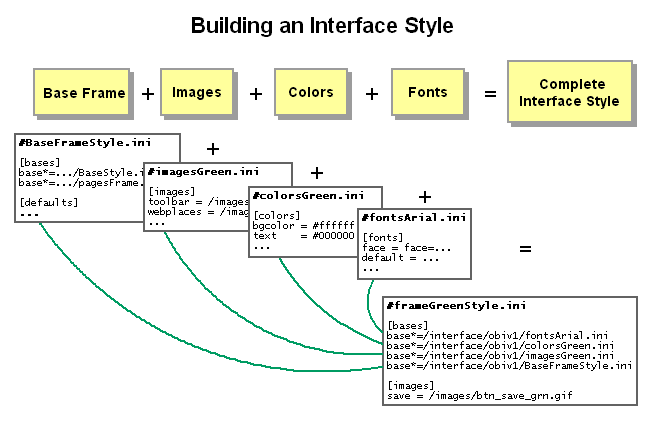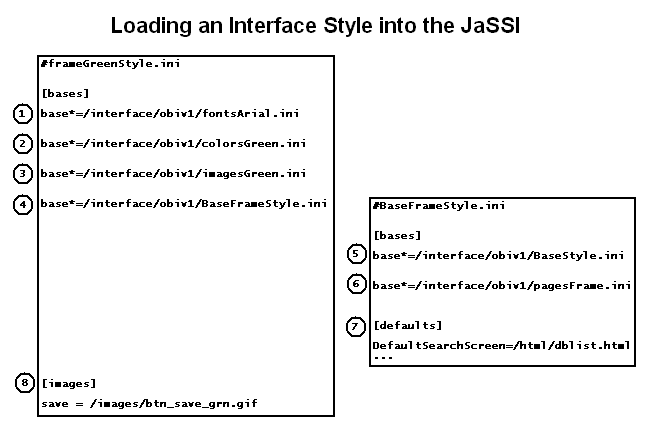BaseStyle.ini and Associated Configuration Files
Contents
Document
Conventions
Introduction
Configuration Files Used to Create Interface Styles
Building an Interface Style
BaseStyle.ini
Combining a Base Style
with Page Information
Adding Information About
Images, Colors, and Fonts
Sharing Configuration Files Across Interface Styles
[bases] Statements
Adding Information to or Replacing Information
from Another Configuration File
Loading an Interface Style into the JaSSI
Developing
Your Own Interface Styles
- <WebZ_root> is the location of your WebZ environment.
- 4.0.x refers to any SiteSearch 4 version prior to 4.1.0; that is, 4.0.0, 4.0.0a, 4.0.1, or 4.0.2.
- All interface style configuration files discussed in this document reside in the <WebZ_root>/ini/interface/obiv1 directory.
SiteSearch 4.1.0 introduces the use of a base interface style (BaseStyle.ini) with information common to more than one interface style and section-specific configuration files with information pertinent to individual interface styles. This arrangement conserves memory because the JaSSI does not need to store multiple copies of the same information for each interface style. It simplifies maintenance of interface style configuration files, since you only need to change information shared by multiple interface styles in one place. Even if you only have one interface style, using smaller configuration files for specific sections of the interface file makes it easier to find specific variable references in a configuration file.
This document describes how BaseStyle.ini and a number of other associated configuration files collectively comprise an interface style. It uses interface style configuration files from the WebZ Out-of-the-Box Interface (OBI), version 1, as examples to demonstrate this concept. The manner in which the sections of an interface style are divided across several files in the OBI, version 1, is not the only possible way to divide these sections. When you build interface styles, you can use this arrangement or any other one that makes sense for your system.
See Interface Style Configuration Files and Interface Style Configuration Files - Sections and Variables for general information about interface style configuration files and specific information about the sections and variables in interface style configuration files, respectively.
| Note: | Site Search 4.0.x versions use a single interface style configuration file for each interface style. |
Configuration Files Used for Interface Styles
In the OBI, version 1, the interface styles use files that contain information in five general categories, as shown in this figure. There is a base style with information common to all interface styles, and individual files with information about the HTML pages, fonts, images, and colors used in an interface style.

You create an interface style by referring to these file types in another configuration file with a [bases] statement.
In the WebZ OBI, version 1, all interface styles are built around BaseStyle.ini, the file that contains information common to multiple interface styles. BaseStyle.ini contains [defaults], [messages], and [anchors] sections and gadget references.
Combining a Base Style with Page Information
The pages files contain references to the HTML files (including files for conducting and refining searches, displaying search results, and for displaying errors to patrons) used in the interface in a [pages] section. For a frames-based interface, these files also contain information about the interface's HTML targets in a [targets] section.
If individual interface styles require different HTML pages, you cannot place the [pages] and [targets] sections in BaseStyle.ini. But it is possible to use the information from BaseStyle.ini and the page-related information from another file by referring to these files in another configuration file, as shown in the following figure:

In the top of the figure, PagesF refers to a configuration file that contains the HTML pages and targets for a frames-based interface, and PagesNF refers to a configuration file that contains the HTML pages for a no-frames interface. The files named Base Frame and Base No Frames refer to configuration files that include references to Base Style and PagesF, or Base Style and PagesNF, respectively.
Now, let's see how the OBI, version 1 demonstrates how to use BaseStyle.ini as the basis of both frames-based and no-frames interfaces. The bottom part of the figure above illustrates this. Two other configuration files, one for a frames-based interface (BaseFrameStyle.ini) and another for a no-frames interface (BaseNoFrameStyle.ini) both contain references to BaseStyle.ini. BaseFrameStyle.ini and BaseNoFrameStyle.ini can serve as base files for a variety of frames-based and no-frames interfaces, respectively.
Both of these files contain a [bases] section, with lines for each configuration file that serves as a base file. In addition, these files contain other information specific to a frames-based or a no-frames interface. BaseFrameStyle.ini refers to pagesFrame.ini and BaseNoFrameStyle.ini refers to pagesNoFrame.ini. pagesFrame.ini and pagesNoFrame.ini both have a [pages] section. The [pages] section in each file lists the various HTML pages used in the frames-based and no-frames interfaces, respectively. pagesFrame.ini also includes a [targets] section for the target frames for the frames-based interface. Both files also contain additional information to override or add to the information in their base files. For example, this line in BaseNoFrameStyle.ini
DefaultSearchScreen = /html/nfdblist.html
replaces the value of the DefaultSearchScreen variable in BaseStyle.ini with /html/nfdblist.html.
Adding Information About Images, Colors, and Fonts
BaseFrameStyle.ini and BaseNoFrameStyle.ini can serve as the basis for a variety of different interface styles by using them in conjunction with other configuration files that describe an interface style's images, colors, and fonts, as seen in this figure:

The figure uses the default interface style from the OBI, version 1, to illustrate this concept. This is a frames-based interface with a green color scheme. The frameGreenStyle.ini configuration file contains references to each of the individual configuration files that contain the information needed for this interface style: imagesGreen.ini for images in an [images] section, colorsGreen.ini for colors in a [colors] section, and fontsArial.ini for fonts in a [fonts] section, respectively. To use these same image, color, and font files in a no-frames interface, you could substitute BaseNoFrameStyle.ini for BaseFrameStyle.ini in the configuration file that refers to the individual files.
Sharing Configuration Files Across Interface Styles
One of the other interface styles in the OBI, version 1 is the noframe style, which uses a no-frames interface. It uses HTML pages with a layout similar to those in the default frames-based style, but the HTML pages are constructed without using frames. To differentiate it from the default style, it uses a blue color scheme rather than the green color scheme used in the default style. The following figure compares the configuration files for the default style with those used for the noframe style.

The default and noframe styles share BaseStyle.ini and fontsArial.ini, which are shaded in gray in the figure.
The noframeBlueStyle.ini file refers to BaseNoFrameStyle.ini, which refers to BaseStyle.ini and pagesnoFrame.ini, the file that points to the HTML pages for a no-frames interface. frameGreenStyle.ini refers to BaseFrameStyle.ini, which also refers to BaseStyle.ini. But BaseFrameStyle.ini references pagesFrame.ini, which points to the HTML pages and targets for a frames-based interface, instead of pagesnoFrame.ini.
noframeBlueStyle.ini uses colorsBlue.ini for its colors and imagesBlue.ini for its images to establish its blue color scheme for screen colors, images, and buttons. In the default style, the colorsGreen.ini and imagesGreen.ini files establish its green color scheme. Both interface styles use fontsArial.ini to specify the font face and font sizes.
frameGreenStyle.ini also includes an [images] section after its [bases] section with one line:
save = /images/btn_save_grn.gif
This line overrides the value of the save variable in the [images] section of imagesGreen.ini, as explained in Adding to or Replacing Information from Another Configuration File.
See the configuration files frameBlueStyle.ini, noframeGreenStyle.ini and framerssStyle.ini for other interface styles that use the configuration files in <WebZ_root>/ini/interface/obiv1 in various combinations.
To use the information from one interface style configuration file in another file, you refer to it with a [bases] statement, like this:
[bases] base* = <WebZ_root>/ini/interface/BaseStyle.ini base* = <WebZ_root>/ini/interface/pagesFrame.ini
An interface style can have more than one base and a file that is a base in one configuration file can have its own base files. For example, BaseFrameStyle.ini has BaseStyle.ini and pagesFrame.ini as its base files. In turn, BaseFrameStyle.ini is a base file for frameGreenStyle.ini.
Adding Information to or Replacing Information from Another Configuration File
You can add lines to any configuration file to supplement information from another interface style configuration file. You can also override information in another configuration file, as long as data from the other configuration file already exists in the interface's style table in the JaSSI. See Loading an Interface Style into the JaSSI for information about the order in which the JaSSI adds data from configuration files into the style table.
For example, this reference in the [images] section of frameGreenStyle.ini (see the graphic in Sharing Information Across Configuration Files):
save = /images/btn_save_grn.gif
overrides the value of the save variable in the [images] section of imagesGreen.ini.
Loading an Interface Style into the JaSSI
When a JaSSI starts up, the Java class that creates style tables, ORG.oclc.gadgets.GadgetAndStyleLoader, finds the style tables to create by reading the [InterfaceStyles] section of JaSSIServer.ini. In the OBI, version 1, the default style specified in JaSSIServer.ini is frameGreenStyle.ini. The GadgetAndStyleLoader class loads information from the configuration files referenced in frameGreenStyle.ini in the order in which they appear in the [bases] section of frameGreenStyle.ini. From frameGreenStyle.ini and BaseFrameStyle.ini, you can determine that the GadgetAndStyleLoader class reads information from the configuration files in this order, as illustrated in the following graphic:
- fontsArial.ini
- colorsGreen.ini
- imagesGreen.ini
- BaseFrameStyle.ini
- BaseStyle.ini
- pagesFrame.ini
- any additional information in BaseStyle.ini
- any additional information in frameGreenStyle.ini

Developing Your Own Interface Styles
We encourage you to use one of these interface styles as the basis of your WebZ interface. We recommend that you always retain backup copies of the files delivered with SiteSearch before developing an interface style.
See Also
Introduction
to WebZ
Interface Display Configuration Files
ObiTopics.ini Configuration File